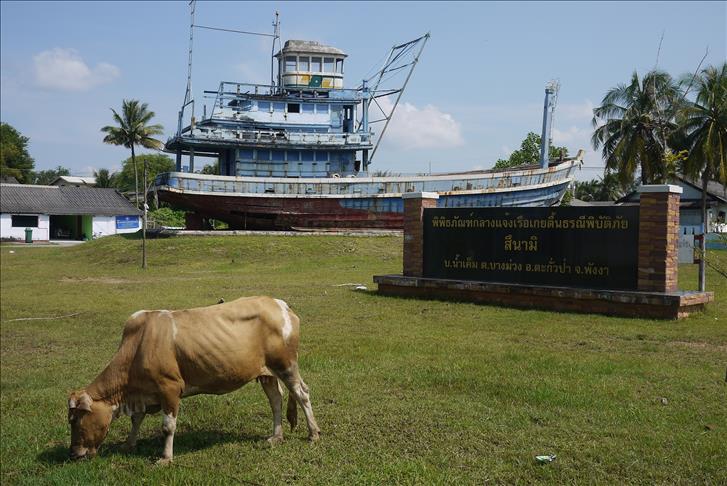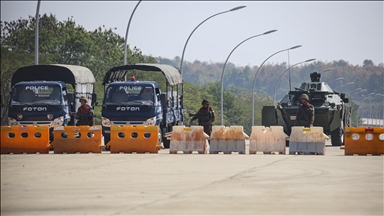
BANGKOK
It was mid-morning on December 26, 2004, in Baan Nam Khem village when a neighbor alerted Chirarat Pheumplian to a “giant wave” coming towards the beach of the small fishing community in southern Thailand.
“I did not know what it was”, said Pheumplian, “so I went out to look”. What she saw still haunts her ten years later.
“It was like a half-moon across the bay and it looked eerily quiet,” she told The Anadolu Agency. “But then the wave came closer and I saw boats being smashed. I called my children and ran.”
Pheumplian had only the time to grab an empty plastic barrel before being carried away by the wall of water.
“I held onto it for seven hours," she recalled. "I wanted to cry but I thought if I did I would lose my strength.” After being tossed by the waves for hours she was finally rescued, only to discover that five members of her family, including her mother and one of her sons, had been claimed by the waves.
In Baan Nam Khem, which lies north of Phuket on Thailand’s picturesque Andaman coast, stories like Pheumplian’s are common. In this 5,000-strong community, where beached trawlers still lie where the tsunami deposited them a decade ago, 1,400 died in the Boxing Day tsunami, making the village a reticent symbol of the tragedy.
Ten years on, the memory of the catastrophe still hovers over a community profoundly transformed by the day’s horrors.
“If you observe, you will see that most people look all the time at the sea,” Buddhist monk Phra Manat told AA.
He arrived in Baan Nam Khem a week after the tsunami to comfort the victims and ended up building a temple called The Temple of Ocean’s Forgiveness.
“The fear is still there,” he said. “They don’t trust the sea. They are afraid of another tsunami.”
A consequence of this terror is that many villagers have abandoned Baan Nam Khem. Another reason for the fall in population is that many lost their family’s fishermen and no longer have a need to remain by the sea.
Nong Chanthawong is a Baan Nam Khem resident who lost her two children and husband in the tsunami. “The human warmth within the community has disappeared,” she said. “Families have dispersed. Many have sold their house and changed their job. Life has been totally changed.”
And here is the paradox. Scores of new houses and community buildings built by the humanitarian organizations and international and governmental agencies are now left empty, put up for sale or rent, giving Baan Nam Khem the strange atmosphere of a ghost village.
“Most donors wanted to make buildings so that they can put the name of their organization on it,” Maneerat Grueneberger, the head of the Love Andaman foundation, told AA.
“They wanted to do something that ‘lives long.’ That is why you can see these very nice, unoccupied buildings.”
Myanmar migrants, usually working on fishing boats or in hotels around the village, often rent the houses abandoned by their original owners, leading some original residents to bitterly complain that “you have now to speak Burmese” to live in Baan Nam Khem.
Of the hundreds of aid organizations that swooped on the village in the months following the tragedy, only a few are left. Most focus on education and work training, such as the Prateep foundation and the New Light foundation, a Protestant group schooling migrants' children.
Protestant organizations were quick to move into Baan Nam Khem and there are now three churches in this Buddhist village where there were none before. In the first months after the tsunami, humanitarian assistance and proselytizing were two sides of the same coin.
“Christians helped us a lot," Pheumplian said. "For a period, I went to their ceremonies, it really helped me. But now I don’t go anymore, I just don’t have the time.”
This combination of religious propaganda and humanitarian work is not always seen as problematic by villagers, who are grateful to anyone who came to help.
“Don’t blame the Christian organizations,” the monk Manat said, joking: “At least they are professional. It is not like us Buddhists. We don’t have any professionals in the humanitarian field.”
He added: “When the tsunami occurred, these organizations were perfectly prepared.”
On Dec. 27 Prime Minister Prayuth Chan-ocha will lead foreign envoys as they visit Baan Nam Khem to mark the anniversary. For some it will be one day to remember the terrible events of ten years ago. For the surviving villagers it is a dread that still lingers in their daily lives.
Anadolu Agency website contains only a portion of the news stories offered to subscribers in the AA News Broadcasting System (HAS), and in summarized form. Please contact us for subscription options.





